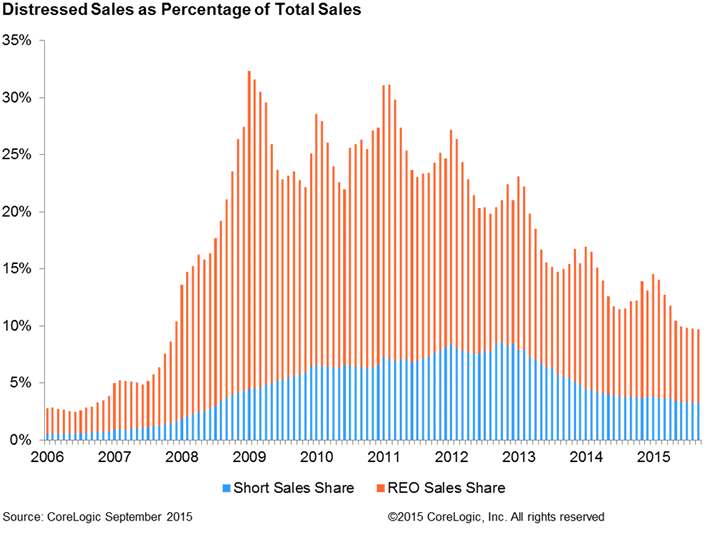Is it our imagination or has the return to normal levels of distressed home sales become an agonizing endurance test? Despite a nearly steady downward trend the market share of distressed home sales in September remained nearly four times the pre-crisis level
CoreLogic said that sales of bank-owned property or REO made up 6.4 percent of all home sales in September and short sales accounted for another 3.3 percent. The combined 9.7 percent distressed home share was down 2.4 percentage points from September 2014 and 0.1 percent on a month-over-month basis.
The REO sales share was the lowest since it reached 6.7 percent in October 2007. From that point REO sales continued to climb, reaching 27.9 percent in January 2009 when combined distressed sales peaked at 32.4 percent.
The short sales share fell below 4 percent in mid-2014 and has remained in the 3-4 percent range since then. CoreLogic said that while distressed sales play an important role in clearing the housing market of foreclosed properties, they sell at a discount to non-distressed sales, and when the share of distressed sales is high, it can pull down the prices of non-distressed sales.

The share of distressed sales before the housing crises generally ran around 2 percent. At the current year-over-year improvement CoreLogic projects distressed sales will reach that mark in mid-2018.
Distressed sales were down from their share in September 2014 in all but eight states. The largest share of such sales were in Maryland at 20.7 percent followed by Florida (19.8 percent), Michigan (19.6 percent), Connecticut (19.1 percent) and Illinois (18.2 percent). The largest annual decline among states was in Nevada where the distressed sales share dropped by 5.8 percentage points. California had the largest improvement of any state from its peak distressed sales share, falling 58.9 percentage points from its January 2009 peak of 67.4 percent.
Three of the five metro areas with the largest share of distressed sales were in Florida led by Orlando-Kissimmee-Sanford, at 22.7 percent, followed by Tampa-St. Petersburg-Clearwater, Fla. (21.5 percent), Baltimore-Columbia-Towson, Md. (21.2 percent), Miami-Miami Beach-Kendall, Fla. (21.2 percent) and Chicago-Naperville-Arlington Heights, Ill. (20.8 percent).







